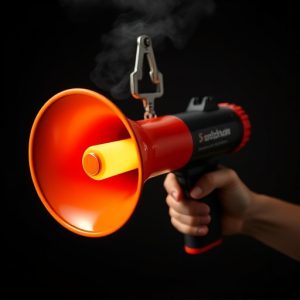Mastering Air Horn Self-Defense: A Comprehensive Guide to Effectiveness and Legal Use
Air horns serve as non-lethal, effective self-defense tools that emit a loud alarm up to 120 decibe…….
Air horns serve as non-lethal, effective self-defense tools that emit a loud alarm up to 120 decibels to deter attackers. They are legal alternatives to traditional weapons, especially where firearms are prohibited, and can be operated with ease under stressful conditions. These devices are particularly useful in crowded settings or when escape is possible. Users must be well-acquainted with both the operation of their air horn and the laws governing its use in self-defense within their jurisdiction to avoid legal complications. Air horns are user-friendly, require no specialized training, and can be carried for immediate access and use. Regular maintenance, including monthly functionality checks and yearly battery replacements, is crucial for reliability. Additionally, training in various scenarios and environmental conditions enhances the effectiveness of an air horn as a self-defense mechanism, ensuring users can confidently rely on this tool to protect themselves when needed.
When considering non-lethal self-defense options, an air horn emerges as a potent deterrent against potential threats. This article delves into the effectiveness and legal implications of using an air horn for self-defense, shedding light on its mechanics, strategic deployment, and the importance of maintenance. We will explore how this device can be a game-changer in signaling for help or disorienting an assailant, and provide guidance on training with your air horn to prepare for real-life scenarios. Embrace the power of an air horn as your self-defense ally.
Understanding the Air Horn as a Self-Defense Tool: An Overview
Air horns are an underestimated yet effective component in personal safety arsenals, serving as potent self-defense tools. Unlike traditional weapons, air horns emit a piercingly loud alarm that can disorient an attacker and deter aggression without the need for physical confrontation or lethal force. The high-decibel sound produced by an air horn can reach up to 120 decibels, which is not only capable of attracting attention from nearby individuals but also can cause significant auditory distress to potential threats. This makes it a non-lethal self-defense option that adheres to legal guidelines in many jurisdictions where conventional weapons are restricted.
When considering the use of an air horn for self-defense, it’s crucial to understand its operational mechanics and strategic deployment. The device is straightforward to operate, with a simple push-button activation, ensuring that even under stress, users can effectively sound the alarm. Additionally, because of its audible range and disorienting effects, the air horn can be an effective tool in crowded areas or when physical escape is possible. It’s also a tool that requires no special training to use, making it accessible to individuals from all walks of life who wish to enhance their personal safety without engaging in combat or handling sharp objects. Users should familiarize themselves with local laws and regulations regarding the use of air horns in self-defense situations to ensure compliance and proper use.
Legal Considerations When Using an Air Horn for Self Defense
When considering the use of an air horn for self-defense, it’s crucial to understand the legal implications that come with this choice. Air horns are primarily designed as a high-decibel noise-making device intended to deter intruders or alert others to an emergency situation. However, in some jurisdictions, their use can be restricted or regulated under self-defense laws. It’s essential to familiarize oneself with local ordinances and statutes that pertain to the deployment of sound-based defense mechanisms. In many places, the law may permit the use of an air horn in self-defense under specific conditions, such as when there is a reasonable belief that one is in imminent harm and there is no other viable escape route. Users must exercise this right responsibly, ensuring that the sound emitted does not cause unnecessary harm or distress to others who are not a threat. Additionally, overuse or misuse of an air horn could lead to legal complications, including charges for disturbing the peace or harassment. Understanding the limits and conditions under which an air horn can be used legally for self-defense is critical for anyone considering it as part of their personal safety strategy. This knowledge not only ensures compliance with the law but also guarantees that the device is used effectively when needed most.
The Mechanics and Effectiveness of Air Horns in Deterring Attackers
Air horns have emerged as a compelling tool for self-defense due to their penetrating sound and deterrent effect. The mechanics behind an air horn’s operation are straightforward yet highly effective. Upon activation, compressed air is released from a canister through a nozzle, causing a tightly focused sound wave to emanate from the device. This acoustic explosion can reach decibel levels that are not only startling but can cause significant auditory discomfort or even pain to an attacker. The high-pitched frequency generated by an air horn can disorient an assailant, potentially incapacitating them long enough for you to escape or seek help.
The effectiveness of air horns in self-defense scenarios is rooted in their ability to deliver a non-lethal, yet potent auditory assault. Unlike some other self-defense mechanisms that may require precision or physical strength, an air horn requires no particular skill to operate effectively. It is a simple, intuitive device that can be deployed with one hand, making it accessible for users of all ages and physical abilities. Furthermore, the disorienting sound can deter not only potential human attackers but also animals in distress situations. The psychological impact of an air horn’s alarm is undeniable, often provoking an immediate retreat from anyone within its effective range, thus serving as a potent means to enhance personal safety when used appropriately in self-defense situations.
Strategic Placement and Maintenance of Your Air Horn
When considering an air horn as a self-defense tool, strategic placement and regular maintenance are key to ensuring its effectiveness when needed. Positioning your air horn in a readily accessible location within your home, vehicle, or personals belongings is crucial for immediate response during an emergency. Ideally, it should be placed on a flat surface that’s easy to reach without searching, such as on a keychain, nightstand, or car dashboard. Regularly testing your air horn is also vital; ensure it’s in proper working order by conducting monthly checks and replacing the batteries at least once a year to avoid a dead device in a critical situation. Keeping your air horn clean and free of obstructions will also prevent performance issues. By maintaining your air horn as part of your self-defense arsenal, you can rely on it to serve its purpose as a powerful deterrent against potential threats. Regular practice in deploying the air horn can further enhance your proficiency and response time during an incident.
Training and Scenario Practice with Your Air Horn: Preparing for Real-Life Situations
When it comes to self-defense, preparation and familiarity with your tools are key components to effective use in a real-life situation. Training with an air horn as a self-defense tool goes beyond understanding its basic operation; it requires practice that simulates potential threats. Regular exercises should include scenarios where the decibel levels emitted by the air horn can disorient or deter an assailant at a safe distance. Users should practice in varied environments to become adept at deploying the device under different conditions, ensuring they can reliably reach for and activate their air horn during moments of stress. Scenario practice is particularly important; it helps individuals anticipate threats and respond swiftly and decisively. By visualizing confrontational situations, users can fine-tune their response times and effectively use the air horn as a non-lethal deterrent. This proactive approach to self-defense with an air horn, through consistent training and realistic scenario practice, can significantly enhance personal safety. It’s crucial to regularly test the air horn in different settings, such as open spaces and confined areas, to understand its limitations and capabilities, thereby ensuring it is a reliable component of your self-defense strategy. Regular maintenance checks are also essential to guarantee the device is functioning optimally when needed most. With consistent training and familiarity with its use, an air horn can be a powerful tool in deterring potential threats and safeguarding personal well-being.


